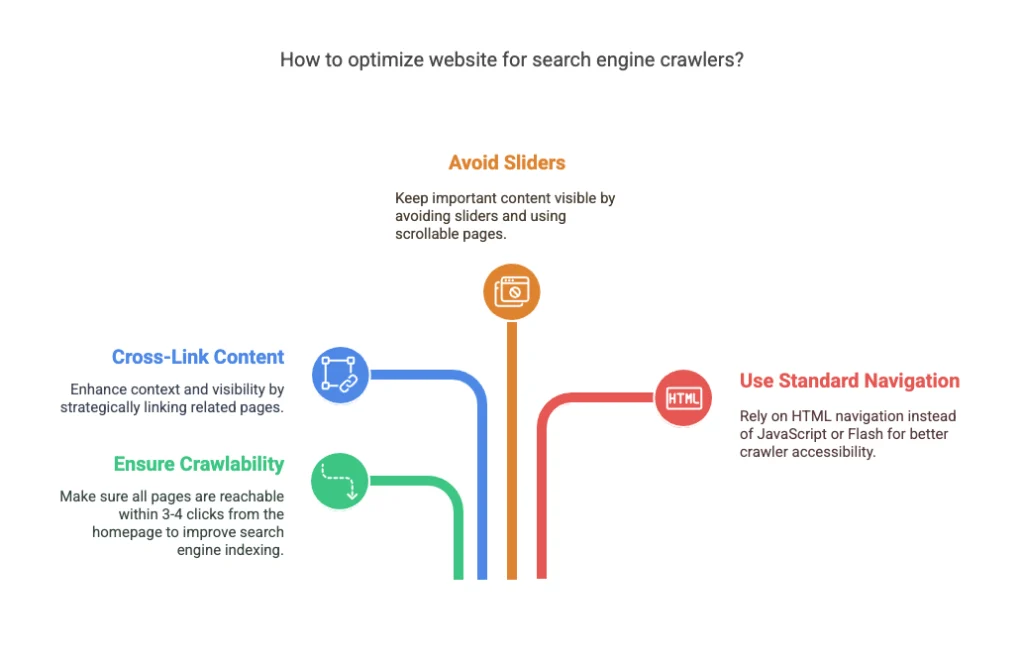However beautiful your site and however compelling your content, all of that effort is wasted if users hit the homepage and can’t figure out where to go from there.
Poorly conceived site architecture is responsible for increasing bounce rates and lowering conversion rates.
And, if you think that you have trouble with shoddy site architecture, spare a thought for poor Googlebot, which is nowhere near as smart as the average user and is tasked with making sense of it all.
I’ve seen websites hide their best content. This content is often in a confusing network of cross-links. Even the most persistent crawler or user won’t find it easily. It would take a miracle. This is a shame.
Companies lose a lot of value this way. This happens because of poorly planned designs. Or, it happens with sites that seem to have no design thought at all. These sites appear to be the result of office politics. They don’t seem to follow any clear design process.
We’re going to take a look at 5 simple, high-level tests that you can apply to your site to determine whether it needs improvement.

Is It Crawlable?
Look at your home page and consider the journey a user must take to the rest of your content. Can they simply follow a short series of links to reach every part of your site? If not, then you likely have areas of the site that are cut off from the rest.
Search engine crawlers navigate websites by following links. They go from one page to another. If some pages or groups of pages cannot be reached this way, the crawlers can’t find them. Consequently, these pages will have no way to appear in search engine indexes.
How Long Is The Ideal User Journey To Conversion?
In ideal circumstances, it should take no more than three or four clicks from the homepage to reach every other part of the site.
However, don’t just fill your homepage with many links. That will still be confusing. Instead, design the entire site structure carefully. Plan how pages relate to each other. This will ensure the path to the content users need is short and clear.
This is very important for sites that want to encourage a conversion. If users must click through many pages before buying something or leaving their contact details, many will quit. A site with a bad information structure is like a leaky bucket. Users will drop off at each extra click in the process.
Is Your Content Richly Cross-Linked?
Search engine crawlers need context. Relevant links between pages help provide this context. When Googlebot crawls your site, it records which pages link to each other. It then tries to understand their relationship. Each link pointing to a page increases its visibility to search engines.
Internal cross linking architectures are a complex topic, and it’s possible to overdo it. Check out this article from Moz for more detailed information.
Are You Hiding Your Best Content In Sliders?
Sliders can display information well. However, they can also hide it effectively. Generally, if important content or branding needs user attention, avoid placing it in a slider.
Spreading information across longer, scrollable pages has become more common. The iPhone 5S page is a well-known example of this trend.
Don’t be afraid to make users scroll; it’s natural for them to do so, which isn’t the case with clicking through sliders.
Is Your Navigation Using JavaScript Or Flash?
This should be clear. If JavaScript or Flash create your site’s navigation, search engine crawlers will likely find them useless. While Googlebot can process some JavaScript, it’s an unnecessary risk to rely on it for navigation.
In Summary
Website architecture is a complex subject, but like the related fields of SEO and CRO, it’s not difficult to understand the basic concepts involved. If you remember only two things from this article, remember:
All content and conversion goals on a site should be reachable in a small number of clicks.
If you can’t get to it with a link, neither can Googlebot.




